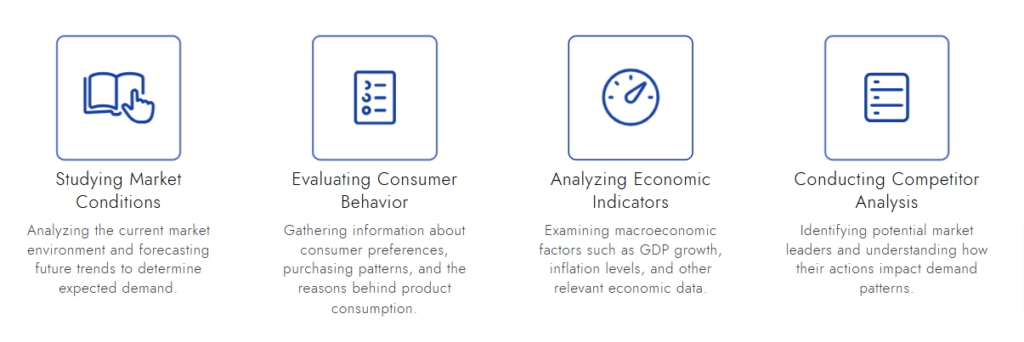In the modern-day context, understanding the business dynamics becomes crucial if a company is keen on remaining competitive, and such a task requires setting aside the right resources. Two of the significant methods that most of the firms tend to use are the heart of gap and the heart of demand analysis. While both are critical for business growth, they have different objectives and bring different benefits. The purpose of this article is to investigate the differences and uses of demand analysis and gap analysis and assist business strategy managers, HR and workforce planners, top management, and investors with the knowledge required to make practical business decisions.

What is Demand Analysis?
Demand analysis is determining and assessing the desire for the particular goods, services or a workforce in the target market or industry. It includes studying market conditions, consumer tastes, and other relevant factors that determine demand for such goods. The insights gathered from demand analysis assist firms in meeting the most likely demand for goods in the market.

Essentials aspects in demand analysis are:
- Market Trends: Analyzing the current condition and forecasting the future to arrive at an expected demand.
- Consumer Behavior: Getting information about likes, purchasing bases, and the reasons why products are consumed.
- Economic Indicators: Looking over the increase of GDP, levels of inflation, and other broad economic indicators.
- Competitor Analysis: Finding potential market leaders and their role in demand changing patterns.
What is Gap Analysis?
Gap Analysis, on the other hand, is about evaluating gaps between the actual and target performance or outcomes of a firm. It exposes critical gaps which need to be filled for optimal use of resources and optimal or improved level of performance.
Key components of gap analysis include:
- Current State Assessment: Analyzing the available capabilities, resources, and performance level.
- Goal Setting: Defining clear, measurable objectives for growth and success.
- Performance Metrics: Comparing current performance against goals using KPIs.
- Actionable Recommendations: Developing strategies to bridge identified gaps.
Demand Analysis vs. Gap Analysis: Core Differences You Should Know
While demand analysis and gap analysis are complementary, they differ significantly in purpose and approach. Here are the primary distinctions:
| Aspect | Demand Analysis | Gap Analysis |
| Purpose | Understand market needs and demand trends. | Identify gaps between current and desired states. |
| Focus | External market factors and consumer behavior. | Internal performance and resource allocation. |
| Outcome | Align offerings with market demand. | Optimize operations to achieve strategic goals. |
| Tools and Techniques | Market research, surveys, and trend analysis. | SWOT analysis, KPI evaluation, and benchmarking. |
How to Leverage Both Demand & Gap Analysis for Better Decision-Making?
Gap analysis and demand analysis focused together enables an in-depth understanding as to the market, positioning as well as the operational strengths and weaknesses of the organization. Let’s examine how:
- Strategic Workforce Planning
- Analysis of demand helps in determining what skills and talent will be required within the organization based on the emerging trends in the market that relates to education and workforce.
- Gap analysis helps the organization in identifying the skill gaps and the inefficiencies which are present in the current workforce.
- Combined, all of these insights assist in coming up with solutions regarding recruiting and upskilling the employees.
- Product Development
- Analysis of demand aids the organization in identifying the consumer’s wants and needs that are not being catered to or are being unnecessarily catered to.
- Gap analysis helps the organization in recognizing products and resources that can be used to suffice these wishes and requirements.
- This creates great insight into how products need to be made or modified to meet consumer requirements.
- Operational Optimization
- Analysis of demand assists in predicting the market demand for the products and thereby determining the resources needed to meet that demand.
- Gap analysis determines whether there is waste or misallocation in the resources within the organization.
- All of these analyses together ensure that resources are utilized in the best possible fashion increasing efficiency within the organization with maximum cost efficiency.
Real-World Applications of Demand and Gap Analysis in Business
There are various industries and operations in which the demand and gap analyses can also be applicable in practice. These approaches are able to deliver practical guidance to firms on meeting market requirements, improving workforce deployment, and optimizing business planning. This section delves into hands-on applications that demonstrate the relevance of such analytical methods to be employed jointly.
1. Workforce Planning in the Education Sector
Demand and gap analyses can easily assist in forecasting programs for educational institutes as well as labor market needs. For example, the future educational needs can be established by examining the gaps in the present syllabuses against the anticipated requirements of new industries, such as in demand for new technology skills.
2. Retail Expansion Strategy
For retail firms, demand analysis provides the opportunity of gaining insight into the most favorable markets likely to yield higher growth and understanding of consumer preferences. While gap analysis, however, helps in knowing whether the organization is ready for the penetration of the particular market by examining supply chain, inventory and even recruiting efforts.
3. Investment Decisions in Technology Firms
Investors can take advantage of demand analysis to assess the possible market that can be covered by Tools and Techniques for Effective Analysis
Step-by-Step Guide to Conducting Demand and Gap Analysis
Conducting demand and gap analysis involves a systematic approach to uncover insights and align business strategies with goals. This section provides a step-by-step guide to help organizations effectively implement these analyses, ensuring they address market needs and operational inefficiencies. By following these steps, businesses can drive growth and make data-driven decisions with confidence.
- Define Objectives: Clearly outline what the analysis aims to achieve, whether it’s understanding market demand or bridging performance gaps.
- Gather Data: Collect relevant data using surveys, interviews, and internal reports.
- Analyze Data: Use analytical tools to derive insights and identify trends or discrepancies.
- Develop Action Plans: Create actionable strategies based on analysis results.
- Monitor Progress: Continuously track performance and refine strategies as needed.
Real-World Case Study: Demand and Gap Analysis in Global E-Learning
Challenge: The platform experienced declining user engagement despite a growing market for online education.
Approach:
- Conducted demand analysis to identify trending topics and preferred content formats.
- Performed gap analysis to uncover deficiencies in content offerings and platform usability.
Outcome:
- Launched new courses tailored to market demand, resulting in a 40% increase in enrollments.
- Enhanced platform features, reducing user drop-off rates by 25%.
Conclusion
Demand analysis and gap analysis are indispensable tools for driving business growth and optimizing resource allocation. While demand analysis focuses on understanding external market trends, gap analysis evaluates internal performance to identify areas of improvement. By integrating these methodologies, organizations can make informed decisions, enhance workforce planning, and achieve strategic objectives.For business strategy managers, HR and workforce planners, corporate executives, and investors, leveraging demand and gap analyses is essential for maintaining a competitive edge. Sign-up on JobsPikr and take the first step towards smarter decision-making by incorporating these powerful tools into your strategic processes.



